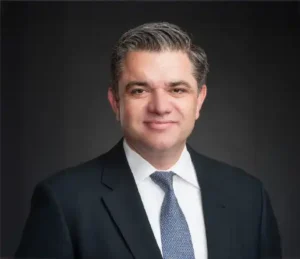The Reverse Shoulder Replacement is a unique shoulder replacement implant that has been used successfully for over thirty years in Europe. It was FDA-approved for use in the U.S. in March 2004. It is designed specifically for use in shoulders that have a deficient rotator cuff, complex fractures, and in difficult shoulder reconstructions and revisions. Dr. Costouros has extensive experience with the reverse shoulder replacement which began prior to FDA approval in the U.S. while in Switzerland. He was one of the pioneers of this procedure in the United States. For select shoulder conditions, the reverse shoulder has offered remarkable results.
The normal shoulder is a ball and socket joint. The ball is called the humeral head and the socket is called the glenoid. The reverse shoulder replacement changes the orientation of the shoulder so that the normal socket (glenoid) now is replaced and with an artificial ball, and the normal ball (humeral head) is replaced with an implant that has a socket into which the artificial ball rests. This type of design completely changes the mechanics of the shoulder. It is specifically designed to be used when the rotator cuff is either absent (torn irreversibly) or when there is significant bone loss.
Indications for The Reverse Shoulder Replacement
Rotator Cuff Tear Arthropathy
Rotator cuff tear arthropathy is a complex shoulder problem that occurs when there is a large tear of the rotator cuff tendons that causes arthritis in the glenohumeral (shoulder) joint. In the normal shoulder, the rotator cuff tendons hold the humerus (ball) centered in glenoid (socket). When there is a large tear, the humerus migrates upward and there is loss of cartilage over time causing arthritis. This type of rotator cuff tear is not repairable. A traditional shoulder preplacement will not be effective because the shoulder will dislocate without a functioning rotator cuff.
A reverse total shoulder replacement corrects the arthritis by eliminating the painful, arthritic joint surfaces and reverses the biomechanics so that the deltoid muscle can do the work of the rotator cuff. Giving the mechanical advantage to the deltoid allows for greater range of motion and strength.
Although the reverse shoulder will eliminate pain and dramatically improve function in select patients, it is not designed to allow one to return to heavy overhead lifting, contact sports, heavy weightlifting, or strenuous activities which could lead to loosening or failure of the prosthesis.
Fortunately, now with the reverse shoulder replacement, many previously unsolvable problems can be effectively treated. Dr. Costouros’ clinical results have been very successful, taking previously non-functioning shoulders and making them once again useful and pain-free.
Shoulder Fractures
Some shoulder fractures are complex and involve the part of the bone where the rotator cuff inserts (the greater or lesser tuberosity). Your surgeon may elect to use the Reverse Prosthesis to fix your fracture instead of the using a plate and screws or a traditional shoulder replacement in certain fractures or if bone quality is poor. Most are better served by the reverse shoulder replacement for alleviating your pain, restoring motion and avoiding some of the potential complications of other forms of fracture surgical treatment.
Complex Shoulder Pathology & Salvage Cases
Because Dr. Costouros is a specialist in the shoulder, we often see patients with complex shoulder conditions that have run out of options. These include failed other shoulder replacements, failed treatment of fractures, failed treatment of instability problems and others. With the reverse total shoulder replacement, many previously untreatable issues can now be effectively treated.
Treatment & Recovery
Before Surgery
After you and Dr. Costouros decide that you are going to have surgery, you will come to the hospital to meet with one of our anesthesiologists. If you have any medical problems (i.e. heart disease, diabetes, asthma) it is important that you see your primary care physician for a full physical and pre-operative clearance. Dr. Costouros may also order additional X-rays and a CT Scan of your shoulder pre-operatively which assists with using special software for virtual planning of your surgery and implants – precision medicine.
Hospital Stay
The day of surgery you will arrive at the hospital two to three hours prior to your scheduled surgery to check in and get prepared by the anesthesiologist and nursing staff. Dr. Costouros will routinely recommend that your anesthesiologist perform a nerve block to help with pain control after surgery. This is called an “interscalene block” and usually involves placement of a catheter. Your anesthesiologist will discuss this with you in further detail on the day of surgery.
You will see Dr. Costouros the morning of your Reverse Total Shoulder Replacement. The surgery usually takes 1-2 hours. The time spent in the recovery room is usually an additional two hours. You then will be transported to an inpatient floor where the typical stay is 1-2 nights. Pain is usually controlled with a combination of the nerve block as well as intravenous or oral pain medications. Before you are discharged home, your pain control regimen will be optimized so that you only require oral medications and are comfortable.
After Surgery
It is important to be on the lookout for signs and symptoms of infections following surgery. These include: fever, chills, nausea, vomiting, diarrhea, redness around your incision, yellow/green drainage from your incision. Shoulder you have any of these symptoms please contact your surgeon’s office immediately.
Physical Therapy
First and foremost, you can do physical therapy at a facility that is close to your home. Physical therapy typically begins while you are in the hospital. For the first three weeks after surgery you will be in a sling always, including sleep. During this time, you may remove the sling for bathing, dressing, and physical therapy only. During the first phase of therapy (Weeks 1-3) you will do pendulum exercises and passive range of motion only. You are not allowed to actively move your shoulder.
Phase II begins three to four weeks after surgery. You can remove your sling and start using your operative arm for activities of daily living. You are not, however, to do any heavy lifting, pushing or pulling of any kind. A good rule of thumb is not to pick up anything heavier than a cup of coffee.
Phase III begins two to three months after surgery. You will begin strengthening with rubber bands and progress to weights.
Physical therapy usually lasts three to four months. Most of the rehabilitation is done on your own home, following the instructions of your physical therapist who receives direct orders from Dr. Costouros.
Follow-Up
You will follow up with Dr. Costouros or his assistant approximately 2 weeks after surgery. Subsequent visits will be scheduled at each visit while we follow your progress. At your follow-up visits Dr. Costouros will check your incision and remove any sutures. He will also obtain X-rays to check the placement of the new shoulder implants.



